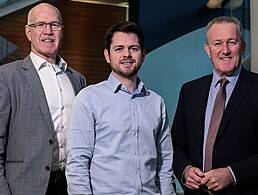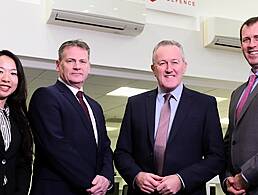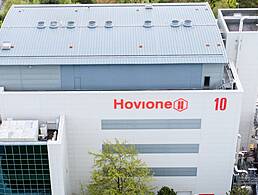NearForm, the four-year old start-up that sprung from the TSSG campus at Waterford Institute of Technology, is to create 100 new jobs over the next 18 months and has opened a new office in Tramore.
The incredible thing about NearForm, a company focused on the Node.js software platform, is that the company already employs 35 people, has taken on no funding. In fact the company has been reaping revenues from day one and is profitable.
The company is to grow to 135 people in the next 18 months and has moved into a new HQ at former Waterford County Council’s old building in Tramore.
NearForm was established in 2011 by chief executive Cian Ó Maidín and chief technology officer Richard Rodger when they spotted an opportunity to better support Node.js software deployments.
Their bet on the technology has paid off and the company is considered a global authority on the vital platform and includes Qualcomm, Intel, Universal, littleBits, DPD and Condé Nast among its global client list.
The success of NearForm and the recent acquisition of its fellow WIT spinout FeedHenry by Red Hat for US$63.5m in cash shows there is something happening in Ireland’s regional South East that shows good software companies can be created anywhere, by the right people and don’t always have to be based in the so-called Silicon Docks of Dublin.
Sun, sea and software
Speaking with Siliconrepublic.com last night Rodger explained that the move to Node.js, the software platform whose applications are written in JavaScript and key to the scalability of IT platforms today, was all about timing and opportunity.
“Node.js is part of a wider context where older technologies like Java have taken too long to build. Traditionally where projects by IT teams would have taken four quarters to build, Node.js lets you do it in quarter the time.
“We spotted the opportunity in 2011 and we rebuilt the Sunday Business Post’s website in 2011. Then more and more clients started coming in. Companies like Walmart and PayPal started deploying Node.js and Condé Nast started to adopt Node.js instead of .Net and Java because it enabled rapid development.
“We are completely self-funded and profitable and we are seen as one of the leading companies in this space in the world.”
A key ingredient in the success of NearForm, in particular, was the company’s decision to establish the world’s first Node.js conference – Node Conf EU – which was in its first year held in the Guinness Store House and attracted 300 delegates from around the world. It has been held every year since then in Waterford Castle, attracting global software luminaries to the sunny South East.
If you study the success of NearForm and FeedHenry, both companies were established by native entrepreneurs who had built careers overseas but wanted to come home.
Rodger explained that that is precisely how NearForm intends to attract the necessary talent to grow.
“These are all technical roles for senior developers, architects and we are looking for people like ourselves. I worked in Germany and wanted to return to the South East.
“We can make a good home for people who feel the same way. They can earn the same in a big city, do high value work, but they can enjoy a better quality of life here.
“We have attracted many former colleagues to return and we hope to attract more. One thing that is different and that wins out over location is the fact that they get to work on one of the hottest areas of technology right now.
“We are quite global in orientation too and we organise meet-ups in London, Dublin and elsewhere to foster our community.”
A hidden gem
Rodger says that a critical mass of software skills has been steadily built up on the TSSG campus, particularly in the Arc Labs building.
“There are 150 people in that one building that have generated lots and lots of start-ups.
“I met my co-founder Cian in that building in 2004 and both of us were on an Enterprise Ireland course.
“In a sense you can grasp the longer term strategy that Enterprise Ireland is putting in place, foundational supports that take a couple of years to develop but once you have the feedback loop in place interesting things start to happen.”
Located close to the beach at Tramore, the new offices are designed to house 100 people but Rodger is already looking at the next wave.
“The reality is that there are always going to be these technology waves. Iona would be a template company for us, they took advantage of a wave in distributed computing and we are taking advantage of a wave where enterprise software development needs to become more efficient, using the right approaches and tools to professionalise software engineering.
“A key aspect to this is the management team all have 10 years’ experience of doing start-ups, there is a lot of graft behind the scenes and plenty of experience and ability that has allowed us to reach our velocity.”




